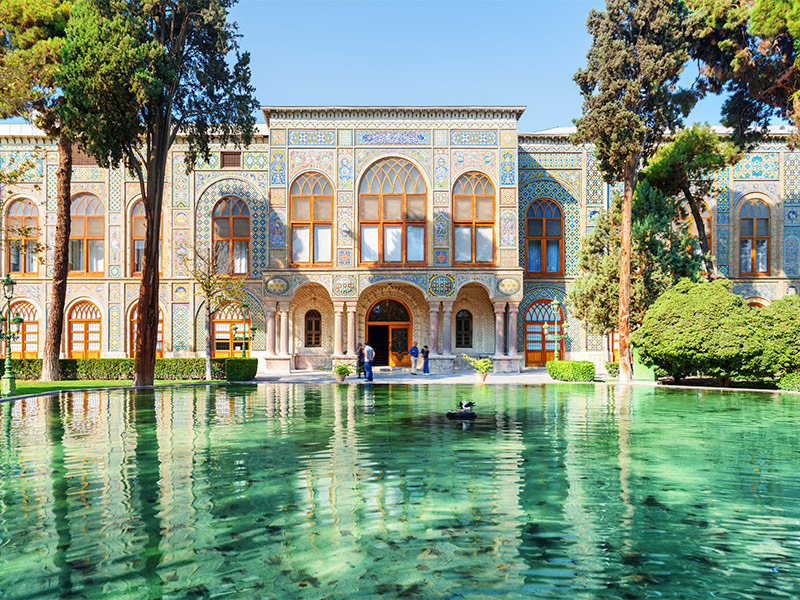Golestan Palace, nestled in the heart of Tehran, Iran, is a testament to the grandeur and opulence of Persian architecture. This UNESCO World Heritage site is not just a palace but a complex of royal buildings that have witnessed the rise and fall of dynasties, the flourishing of art and culture, and the evolution of Persian history. In this article from Eligasht, we will delve deep into the history, architecture, and significance of Golestan Palace. stay with us.
Book Iran Air flights from London to Tehran and Tehran to London with Eligasht UK:
Historical Background of Golestan Palace
According to documents and the travelogue of Pietro Della Valle, Golestan Palace’s history dates back to the time of Shah Abbas Safavid. However, its most significant period is associated with Agha Mohammad Khan Qajar. After his victory over Lotf Ali Khan, he ascended to the throne in 1791 and chose Tehran as the capital, thereby elevating the importance of the Golestan royal palace.
Nasser al-Din Shah Qajar, the first Iranian king to travel to Europe, also had his coronation ceremony in this palace. Consequently, Golestan Palace underwent significant changes and adopted a new appearance influenced by European architecture. Throughout the Qajar era, this complex served as a center for governance, a royal residence, and a place for training artists and architects, making it a significant hub for artistic production in the 19th century.
During the reigns of Mozaffar al-Din Shah, Mohammad Ali Shah, and Ahmad Shah Qajar, no major changes occurred in this royal palace. However, this period is important due to significant historical events such as the Constitutional Revolution and its aftermath. Golestan Palace also experienced changes during the Pahlavi era.
Given these facts, this Palace has a history spanning over four centuries and preserves a remarkable collection of Iran’s historical heritage. This palace stands as a valuable witness to some of Iran’s most significant moments in history. Currently, the palace is surrounded by hidden and modern structures, intertwined with the diverse architecture of Tehran.
UNESCO World Heritage Site
In 2013, Golestan Palace was inscribed as a UNESCO World Heritage site, recognizing its outstanding universal value. The palace complex is a remarkable example of the synthesis of Persian and Western architectural styles, reflecting the historical interactions between Iran and Europe.
Why Should We Visit Golestan Palace?
Golestan Palace is a historical complex that includes various palaces and royal halls. Its architectural style is rooted in Iranian traditions but has evolved through commercial, political, and cultural exchanges with European countries. This has resulted in a unique blend of Iranian and European neoclassical architecture, creating a visual spectacle that is worth experiencing at least once.
One of the standout features of Golestan Palace is its exceptional tilework, which depicts a range of themes such as myths, hunting, love, war, landscapes, historical artifacts, kings, courtiers, government officials, and religious motifs. These artworks reflect the influence of increased Western interactions and support for the arts, skillfully incorporating Western painting techniques like perspective, shading, and naturalism alongside traditional Iranian methods.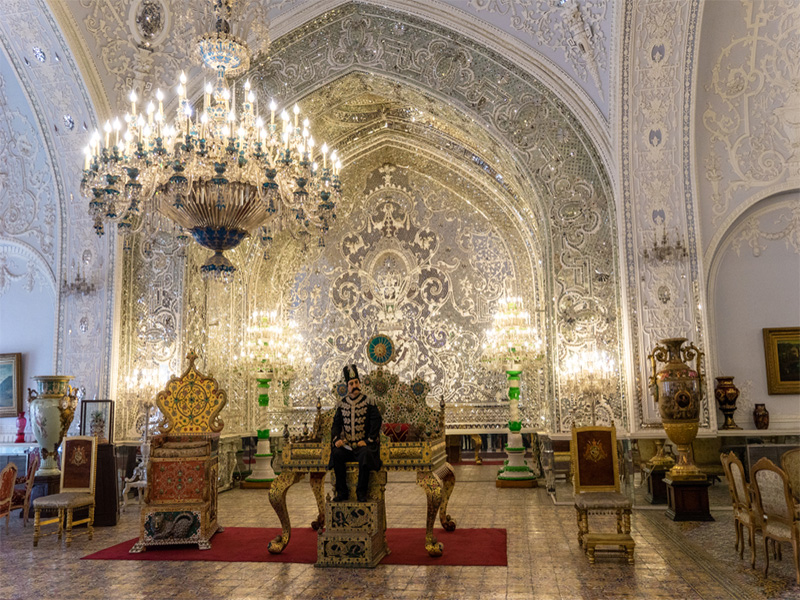
The exterior of Golestan Palace is not the only aspect that amazes visitors. Upon entering, the magnificent mirror work, especially in the Hall of Mirrors, which took over seven years to complete, leaves visitors in awe. The gilded decorations on stone surfaces, such as those in Shams-ol-Emareh and the Marble Throne, further enhance the palace’s allure, showcasing a popular style from the Qajar period. Skilled jewelers of that time used metal sheets in these decorations to display their craftsmanship. The use of gold in Golestan Palace’s architectural embellishments, along with an emphasis on durability, adds to the collection’s value.
Architectural Marvels
Shams-ol-Emareh
One of the most iconic structures within Golestan Palace is the Shams-ol-Emareh or the “Edifice of the Sun.” This five-story tower, built in 1867, was inspired by European architecture and served as a symbol of modernity and progress. The tower offers a panoramic view of Tehran and is adorned with intricate tilework and stucco decorations.
. This towering structure has long been a symbol of the capital and is one of its most notable attractions. Inspired by the skyscrapers he saw during his European travels, Naser al-Din Shah commissioned the construction of this building. Constructed in 1284, this five-story building was the tallest of its time, standing at a height of 35 meters. Shams al-Amareh was groundbreaking in its use of metal in construction, marking a significant advancement in Iranian architecture.
Marble Throne
The Marble Throne, or Takht-e Marmar, is another architectural gem within the palace complex. This exquisite throne, made of yellow marble, was constructed in 1806 by the order of Fath-Ali Shah. The throne is intricately carved with floral patterns and mythical creatures, showcasing the craftsmanship of Persian artisans. The throne’s design evokes the image of King Solomon’s throne, featuring three demons, six angels or humans, a dragon, and two lions. Verses praising Fath Ali Shah from Malik al-Shu’ara are also engraved on this marble masterpiece.
Related post
Masoudieh Mansion, Tehran: Iran’s First Museum and Library
Battle of ice and fire in Tehran Ab-o-Atash Park
Salam Hall
Also known as the Museum Room or the Coronation Hall, Salam Hall is located in the northwest corner of Golestan Palace. Initially intended to be a museum, Naser al-Din Shah decided to create a museum similar to those he had seen in Western countries. Consequently, the old buildings in this section of the garden were demolished to make way for the museum room, pool, and other structures. Thus, Iran’s first museum took shape in Golestan Palace. The history of photography and the establishment of museums in Iran dates back to the Qajar period. The construction of Salam Hall and other sections was completed in 1293 AH, but the arrangement, installation of panels, and completion of decoration continued until 1296 AH. It appears that Naser al-Din Shah himself participated in the design of the museum’s layout.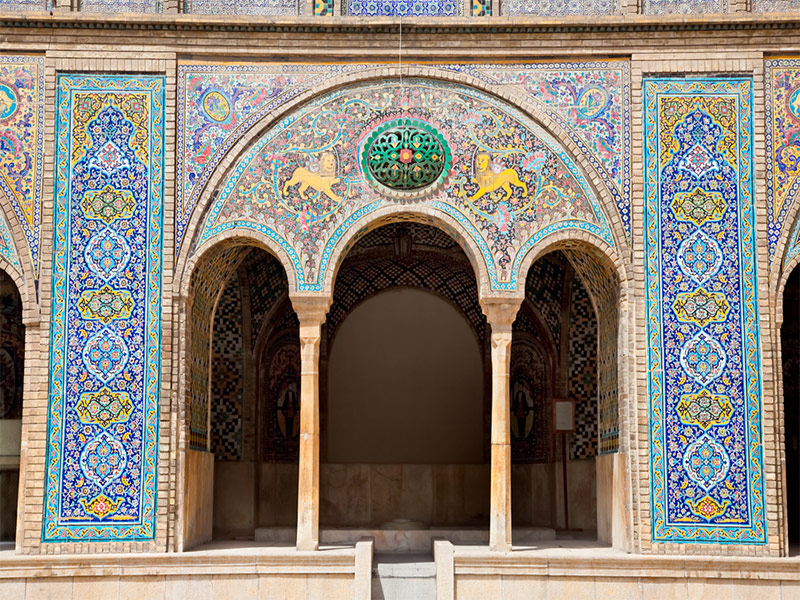
Since salutation ceremonies were held in this area, it became known as Salam Hall. Later, it was recognized as the Coronation Hall due to the coronations of the Pahlavi kings.
Ivory Hall
The Ivory Hall is another magnificent structure within the Golestan Palace. Although the exact date of its construction is unknown, it is believed to have been built before the Salam Hall and the Mirror Hall, based on available evidence. The hall’s beauty is captured in an oil painting by Mahmoud Khan Malek al-Shoara, drawn in 1908, which shows the hall’s exterior view with three large arches, an Ivan with six columns, and a staircase. Currently, the hall houses two large elephant ivory sculptures, which may explain its name. However, some believe that the hall was originally used for receptions and dining, and its correct name is “Aj Hall,” meaning “hungry” in Turkish.
Gifts Hall
gifts Hall was constructed in 1965 on the remains of a Qajar-era structure. As the name suggests, it is used to preserve and display gifts from European countries to the Qajar kings. Among these gifts are a Chinese service from the Napoleonic wars, a jeweler’s service presented by Queen Victoria, a service from Alexander III, and another from Nicholas I of Russia. Visiting these gifts offers a delightful experience.
Brilliant Hall
The Brilliant Hall is known for its cream-colored decorations and splendid chandeliers. Before the Brilliant Hall was established, a Crystal Hall existed in its place during the time of Fath-Ali Shah. The Crystal Hall was demolished during the reign of Naser al-Din Shah due to deterioration, and the Brilliant Hall was built in its place. During the reign of Mozaffar al-Din Shah, the hall underwent restoration, and beautiful decorations were added. An oil painting of the hall before this restoration is kept in the Salam Hall. During Naser al-Din Shah’s reign, the Brilliant Hall was used to store gifts from foreign kings, and during the Pahlavi era, it served as a venue for official court receptions.
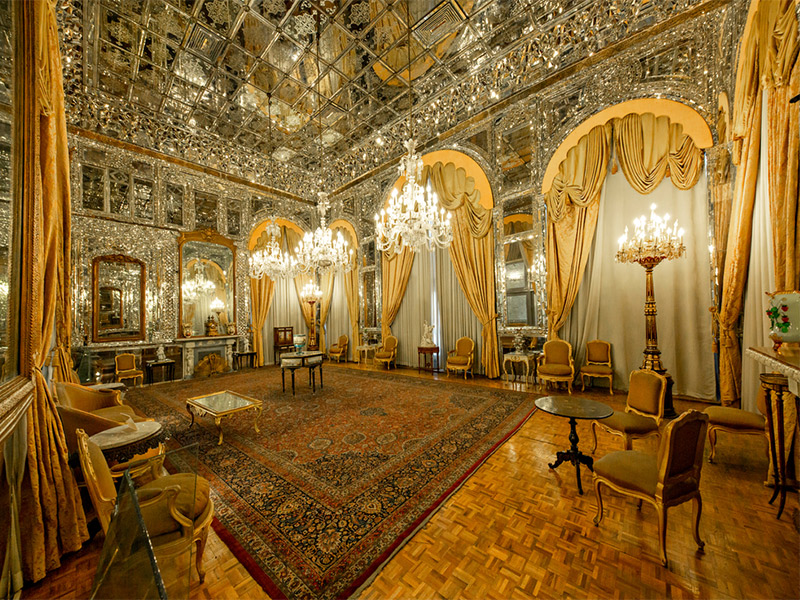
Talar-e Ayeneh
The Mirror Hall is one of the most famous halls in the Golestan Palace. It is located adjacent to the Salam Hall and is renowned for its mirrored walls and intricate curtains. The hall gained much of its fame from a well-known painting by Kamal al-Molk, which depicts Naser al-Din Shah in the Mirror Hall. The painting took five years to complete and is notable for its depiction of the hall’s grandeur, which appears much larger than its actual size, showcasing the artist’s skill in magnifying its splendor.
Khalvat-e Karimkhani
Another structure within the Golestan Palace complex is Khalvat-e Karimkhani, which is one of the oldest surviving buildings. Originally constructed during the reign of Karim Khan Zand, it has undergone modifications over time. It was located adjacent to the Salam Hall and served as a passage between the palace interior, Golestan Garden, and the Marble Throne Veranda. Naser al-Din Shah made changes to this section, demolishing significant portions to make way for the new hall. Khalvat-e Karimkhani holds historical significance, as it was a favored spot of Naser al-Din Shah who spent solitary moments there. Today, it houses valuable artifacts such as the tombstone of Naser al-Din Shah and the Fath Ali Shah Qajar throne. The Golestan Palace Museum preserves a precious painting by Kamal-ol-Molk called “Khalvat-e Karimkhani,” depicting the beauty and tranquility of this area.
Abyaz palace
The Golestan Palace complex includes several notable structures, one of which is the Abyaz Palace. Its construction was commissioned by Naser al-Din Shah to accommodate the valuable gifts he received, particularly from Sultan Abdul Hamid of the Ottoman Empire. As the existing palace buildings were already occupied, a new building was designed in the southwest corner of the palace specifically for these gifts. The name “White Palace” originates from the Arabic word “Abiaz,” meaning white, which accurately describes its appearance. The palace follows the architectural style of 18th-century Europe and features white paint and marble, adding to its elegance. Aside from storing Ottoman gifts, the White Palace also served as a government office and a venue for official meetings. Today, it functions as an ethnographic museum and a popular tourist attraction in Tehran, occasionally hosting workshops and classes.
The Badgir Mansion
The Badgir Mansion, constructed during the reign of Fath Ali Shah Qajar, is another notable structure in the Golestan Palace complex. It derives its name from the tall windcatcher (badgir) adorned with intricate woodwork. This windcatcher provided a cool and pleasant environment during hot summer days, serving as a resting place for palace residents. The Badgir Mansion underwent significant repairs and renovations during Naser al-Din Shah’s reign. Notably, it was the location of Mozaffar al-Din Shah Qajar’s coronation ceremony.
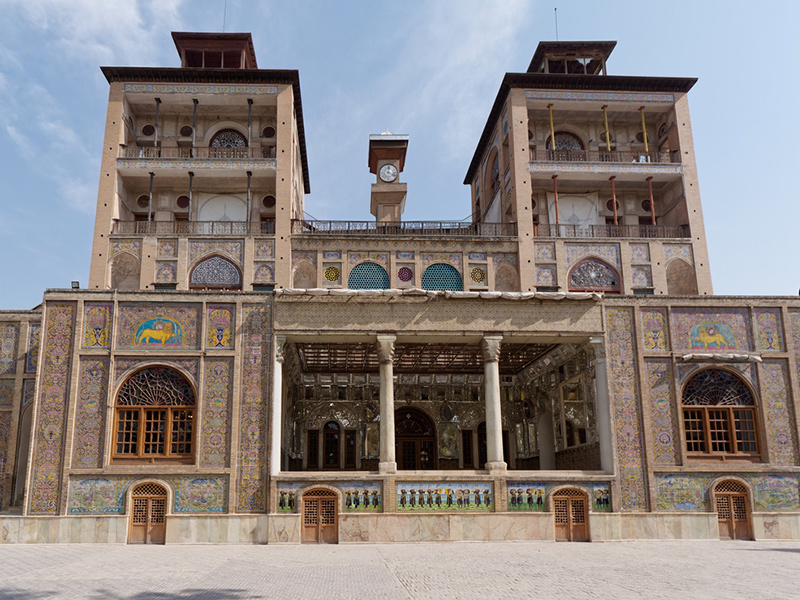
Special Museum
The Special Museum is part of the pool house of Salam Hall and houses precious objects left behind by the Qajar kings. Some of these items were previously kept in Naser al-Din Shah’s museum room, dating back to earlier periods of the Qajars. Others were gifts from contemporary kings and artists or were purchased by these kings themself
Museum Gallery
One of the prominent sections of the Golestan Palace is the Museum Gallery, which is dedicated to showcasing paintings from the Qajar period. This gallery is divided into two main parts. The southern section features paintings from the Qajar era, with works by artists such as Mirza Baba Naqqashbashi Shirazi, Esma’il Jalayer, Abu’l-Hasan Sani’ al-Akbar Khan Mozayyen al-Dawlah, and others. The northern section is dedicated to the works of later Qajar painters, including Mahmoud Khan Saba, Kamal al-Molk, Mosavvar al-Molk, and Agha Mirza Musa. These two sections were merged in 1995 and officially began operating as the Museum Gallery in 1998.
Visiting Golestan Palace
Golestan Palace is conveniently located in the heart of Tehran, making it easily accessible to visitors. The palace complex is situated near key landmarks such as the Grand Bazaar and Tehran’s main square, providing a perfect starting point for exploring the city’s rich history and culture.
Visitor Information
Visitors to Golestan Palace can explore various sections of the complex, including the museums, galleries, and gardens. The palace is open to the public throughout the year, with guided tours available to provide in-depth insights into its history and architecture. It is advisable to check the official website for the latest information on opening hours and ticket prices.
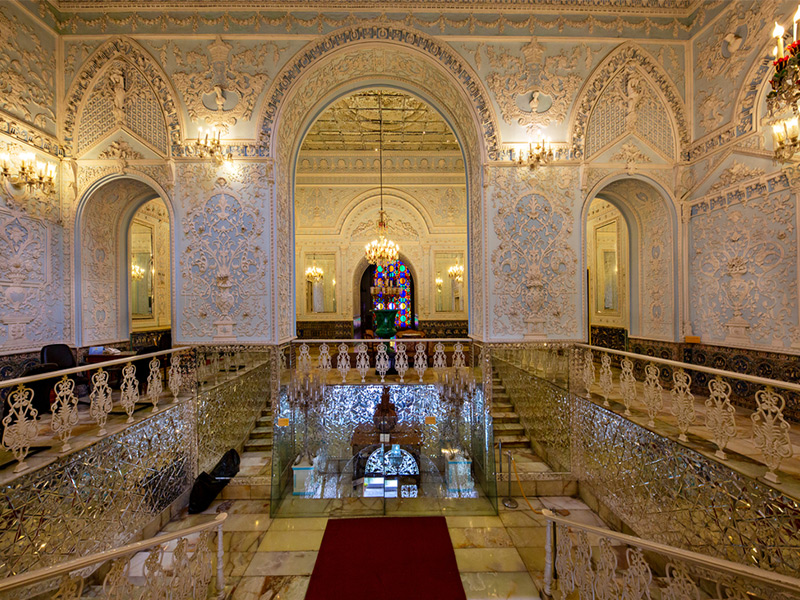
Final words
Golestan Palace is not just a historical monument but a living testament to the rich cultural and architectural heritage of Persia. Its significance, architectural marvels, and cultural treasures make it a must-visit destination for anyone interested in exploring the grandeur of Persian history.
FAQ
-
What is the significance of Golestan Palace in Persian history?
This Palace holds immense significance in Persian history as it was the royal residence and the seat of government during the Qajar Dynasty. It served as the epicenter of political and cultural activities, witnessing numerous royal ceremonies, diplomatic receptions, and significant historical events.
-
When was the Golestan Palace built?
The construction of the Palace began in the 16th century during the Safavid era, but it was extensively renovated and expanded during the Qajar Dynasty, particularly in the 19th century under the reigns of Fath-Ali Shah and Naser al-Din Shah.
-
What architectural styles are represented in this Palace?
Golestan Palace is a remarkable example of the synthesis of Persian and Western architectural styles. The complex features traditional Persian elements such as intricate tilework, stucco decorations, and mirror work, alongside European influences seen in structures like the Shams-ol-Emareh.
-
What are the main attractions within Golestan Palace?
Some of the main attractions within the Palace include the Shams-ol-Emareh (Edifice of the Sun), the Marble Throne (Takht-e Marmar), and the Hall of Mirrors (Talar-e Ayeneh). The palace complex also houses several museums and galleries showcasing Persian art, carpets, ceramics, and manuscripts.
-
How can visitors access Golestan Palace?
This Palace is located in the heart of Tehran, near key landmarks such as the Grand Bazaar and Tehran’s main square. It is easily accessible by public transportation, including metro and buses. Visitors can explore various sections of the palace complex, with guided tours available for a more in-depth experience. It is advisable to check https://www.golestanpalace.ir/en for the latest information on opening hours and ticket prices.
